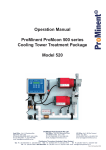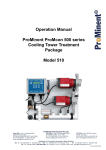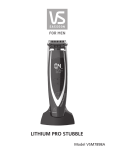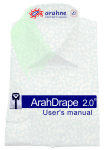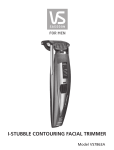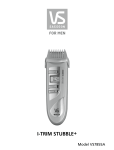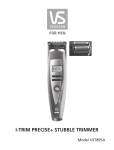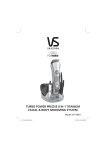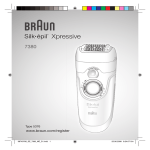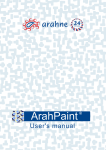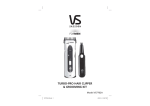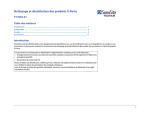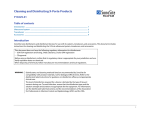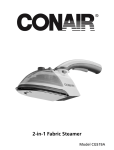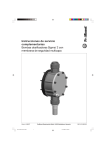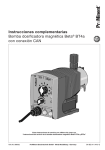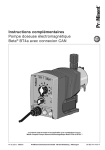Download 1 HGC-200 Operating Instructions.indd
Transcript
HGC-200 Hydro Gas Chlorinator ProMinent Fluid Controls Pty Ltd Head Office: Unit 4, 4 Narabang Way BELROSE NSW 2085 AUSTRALIA (PO Box 85, BELROSE WEST NSW 2085) Phone: (02) 9450 0995 Fax: (02) 9450 0996 Email: [email protected] Web: www.prominentfluid.com.au Brisbane Office: 1048-1054 Beaudesert Road COOPERS PLAINS QLD 4108 Phone: (07) 3246 5200 Fax: (07) 3246 5225 Email: [email protected] Melbourne Office: Unit 2, 88 Star Crescent HALLAM VIC 3803 Phone: (03) 8795 7430 Fax (03) 8795 7431 Email: [email protected] Sydney, 1st August 2003 ® READ THESE INSTRUCTIONS COMPLETELY BEFORE YOU BEGIN. Chlorine gas is potentially dangerous and should be handled with respect and care. ProMinent IMPORTANT Ammonia gas should not be stored or fed in the same room with chlorine. Contact of the gases may result in an explosive mixture. SAFETY FIRST: Refer to AS2927 For details of wearing gas masks. Keep the cylinder wrench on the valve for fast shut off. Have plastic squeeze bottle approximately 1/4 full of ammonia solution for testing leaks. 1. Valve protection cover must be on Ton container & cylinders before they are moved. 2. The ton container should be level. 3. Always place Tonne container so valves are at vertical position and use only the top valve which is the gas valve. BOTTOM VALVE IS LIQUID—DO NOT USE. 4. For best operation and safety, the Ton containers, cylinders and Chlorinators should be protected from the elements and direct sunlight. 5. NEVER apply heaters or heat lamps directly on a Ton container or cylinder. Corporation Cock or PVC Valve ® NOTE: Unpack Chlorinator from shipping case. Check that all compenents are present and undamaged. Piping hook-up to Ejector A. Ejector injection point should be installed at the point of lowest back pressure in main and at a sufficient distance downstream so chlorinated water is not recirculated through the booster pump. NOTE: However, where residual control is used the dosing point is prior the take off point for booster pump. NOTE: Booster pump suction should be 3 meters away from ejector injection point. On larger pipe diameters of 150mm or greater, a distance of 10 times the pipe diameter should be maintained. NOTE: Booster pump suction and ejector must be from the side of pipeline, not from top of the main. B. On water inlet side to ejector nozzle, a gate valve, Y strainer, and pressure gauge should be installed in that order. Ejector supply line size should as a minimum be the same size as ejector inlet. C. Attach solution hose, or PVC pipe, to discharge side of ejector and connect via hose to injection fitting. D. A wall mounting ejector bracket can be provided together with injection fittings. E. Tighten all vacuum fittings hand tight. TESTING EJECTOR Now test to see there is sufficient pressure to operate the ejector. Also check that the booster pump (if fitted) is operating in the proper direction. A. If you are operating with just city water pressure, (no booster pump) by turning on the inlet valve to the ejector there should be a vacuum or suction at the fitting on the side of the ejector. 5. Inspect for and remove any debris found on the chlorine container valve or on the outlet gasket surface. Do not use a screwdriver or sharp tool to clean. 6. Before mounting, remove all tags and tape from the Chlorinator. 7. Loosen yoke half-dog until the valve plate can be pushed all the way back. 8. Place new fibre or lead gasket over chlorine inlet assembly. Never re-use the same gasket. ProMinent INSTALLATION OF HYDRO EJECTOR 9. Mount Chlorinator on cylinder valve with yoke over the valve with the inlet and outlet properly aligned. Tighten the yoke screw while making certain the gasket has not fallen out. Excessive tightening can damage the gasket or yoke screw. 10. On Ton containers, Place weight support, found on Chlorinator drip leg, over the lower valve. 11. On Ton containers, Warm liquid drip leg by plugging in 25watt heater. This must be turned on 15 minutes before start-up. CONNECTING VACUUM LINES BETWEEN CHLORINATOR AND EJECTOR, AND CHLORINATOR VENT TO OUTSIDE 1. Upper connector on right top of Chlorinator is for 12x8 vacuum line tubing to ejector. (Allow enough vacuum tubing for changing cylinders.) 2. Connect 12 x 8 vacuum tubing to lower connector on Chlorinator and vent to safe area outside of building, see AS2927. (Place insect screen outside on end of vent tubing.) CHLORINATOR VACUUM TEST 1. Do NOT turn on chlorine cylinder valve until you have completed vacuum test on system. a. Vacuum test Note 1: Ejector must have some back pressure or you will get jetting. Note 2: When chlorinating into a contact chamber, a tee should be installed on the solution line with a vacuum breaker to prevent siphoning. B. If using a booster pump, turn on the valve in the water inlet line and the pressure gauge should indicate a boost of at least 3 bar greater than pressure at the booster pump inlet. If pump is operating in proper direction, there should be a strong vacuum at the fitting located on the side of the ejector. Place your finger over the fitting on side of ejector and you will feel the suction. C. If the ejector has tested satisfactory, you are ready to mount Chlorinator. D. On start-up, the nozzle may become plugged due to filings, solder, or other pipe debris from installation. Clear debris if required. INSTALLATION OF CHLORINATOR Open the rate valve on the Chlorinator two or three turns. With the chlorine cylinder still closed, start the ejector booster pump,in about a minute the metering ball will drop to the bottom of the metering tube. If the ball continues to bounce there is either a leak at the (lead) gasket or a loose connection at the vacuum tube fittings or meter tube. Tighten connections and recheck. (The tube fittings should be hand tight. It is not necessary to use pliers or wrench on these fittings. If meter tube needs tightening, use a coin and finger-tighten.) b. If the ejector is operating properly, pulling sufficient vacuum, the indicator on the front of the Chlorinator should show red. c. Turn off water supply to ejector. d. Wait 5 to 10 minutes with the water supply off. Turn the reset knob on front of Chlorinator. The indicator should continue to show red. (If red continues to show you have a vacuum tight system.) 1. After the chlorine cylinder has been properly installed, remove valve protector cap. e. You can now proceed if the system is vacuum tight. 2. Chlorine Ton container valves must be in the vertical position with one valve directly above the other. f. Disconnect vacuum tubing at top of Chlorinator to allow air to enter system. Reconnect tubing. 3. Look at position of top valve, if it faces to or opens on left, a left hand Chlorinator is required. Check Chlorinator to see if you have a left-hand unit. 2. Turn reset on front of vacuum regulator and now it should show grey. 4. Prior to removing valve cap covering the chlorine container valve outlet, make certain the valve is in the closed position. Proceed by removing the cap slowly. NOTE: Do not connect vent lines from two Chlorinators to one common vent. You must run separate lines to the outside when using two Chlorinators. ® Material necessary: A small plastic squeeze bottle, 1/4 full of household ammonia, for checking chlorine leaks. By squeezing the bottle the ammonia fumes directed at the lead or fibre gasket will show a white smoke if a chlorine leak is present. 1. Turn booster pump on. 2. Open the rate valve on flow meter assembly for low flow (about two full turns open). b. Exhaust fan turn on switch should be located near out side entrance with alternate outside turn on switch. c. Chlorine cylinder wrench should remain on the cylinder. d. Plastic squeeze bottle 1/4 full of household ammonia. e. Buddy system used (two people capable of operating system). 2. If a leak is detected the following should be checked first. 3. Open chlorine cylinder-valve 1/4 turn and close immediately. Do not strike the cylinder wrench to open valve. a. The lead or fibre gasket between the chlorine cylinder valve and the vacuum regulator inlet assembly. 4. Squeeze ammonia bottle fumes around lead gasket at cylinder connection and rate valve bonnet, two fittings on Chlorinator. If chlorine is leaking, a white smoke will appear. If no smoke appears, proceed. (1) Tighten half dog screw on vacuum regulator yoke assembly that is used to secure inlet assembly to chlorine cylinder valve. (Do not use excessive force.) (2) Always use a new gasket. CORRECT LEAKS BEFORE PROCEEDING! 5. Turn on cylinder valve 1/4 turn and leave open. (Recheck again for leaks.) b. Chlorine leaking out the vent due to the Inlet safety shut off valve having dirt on the valve seal. (1) Turn off chlorine cylinder valve. 6. Adjust rate valve to desired rate. 7. Do not use rate valve as shut off valve. To shut off chlorine, close the cylinder valve. (2) Wait until the metering ball drops to zero on the flow tube. (3) Turn off water supply to ejector. 8. Read rate of flow at centre of ball. SYPHONING ACTION When EJECTOR is placed above water, the fall of water in solution line may create a siphoning action. This may require a vacuum break. (A “T” with a ball check valve that will allow air into solution line when booster pump or water to ejector is turned off). (4) Now you may remove the vacuum regulator from the cylinder valve provided the red indicator is showing no chlorine pressure. (RED should be showing.) C. Servicing the inlet safety shut off valve. (1) Remove the two screws holding the metal yoke plate to the vacuum regulator body. SHORT PERIOD SHUT-DOWN 1. Shut off water supply. 2. Shut off chlorine container valve. Do not use rate valve as shut-off valve. 3. Drip leg heater remains on, on Ton container. EXTENDED SHUT-DOWN 1. Shut off cylinder valve. 2. Turn off ejector water supply. 3. Drip leg heater must be on 15 minutes before restart on ton container. System will use up all chlorine in vacuum system and go on vacuum. Before start-up you would have to break vacuum. Use new lead or fibre gasket each drum/ bottle change. Also replace Filter material SERVICING THE HYDRO SYSTEM HYDRO Gas Chlorinators when operated according to instructions will require little service. The following is concise summary to aid you in reliable service. 1. Pressurised chlorine leaks are a safety hazard to life and equipment and should be corrected immediately. When searching for this type of leak there are basic safety rules to follow. a. Air breathing pack should be readily available. (2) Grab the metal yoke and with a slight turning motion pull the yoke out of the Chlorinator body. (3) With a small screwdriver remove T-210 Filter and this will place the valve and seat at your finger tips. (4) Insert a small screwdriver in valve slot and hold vent plug (it’s shaped like a bullet) and unscrew. (5) Examine the Teflon valve seat and valve-sealing plug. ProMinent START-UP OF CHLORINATION ® Teflon Seat Solid Silver Needle (a) Do not use screwdriver or sharp object to clean valve plug or seat. (b) Use a soft, clean cloth with acetone to clean valve plug, valve seat and valve bullet. (6) Assemble in the reverse order. Do not use pliers to hold (bullet) use your fingers and turn slotted valve with correct size screwdriver. Be certain you put tiny silver washer on valve plug. Also turn seal plug back into inlet adapter hand tight. (7) For manifold mount clean and replace S-275 Filter. For Ton mount fit new FG-40 Filter Pad. (8) After mounting Chlorinator with a new gasket pull a vacuum test before you turn on cylinder valve. See Start Up of Chlorination. NO CHLORINE FEED No vacuum being produced by ejector? 1. Remove EVA tubing from ejector fitting and place your finger on it and you should feel good suction. (1) Shut off cylinder or Ton container valve. (2) Remove vacuum regulator. (3) Remove S-275 Silver filter (4) Wash silver screen, Teflon holder, and “O” ring in hot soapy water, rinse and air dry. (5) Insert back in inlet assembly. (6) Be sure to replace lead gasket ProMinent To clean the filter, Manifold Mount: To clean the filter, Ton Mount: (1) Shut off cylinder or Ton container valve. (2) Remove vacuum regulator inlet valve. (3) Remove two hex bolts to separate iron-work from body plate. (4) Filter in Inlet valve holder is Silver screen S-275 and Fibreglass Filter Pad. Clean the silver screen as below and replace the Filter pad FB-40. (5) Filter in the Ironwork assembly is silver screen in Teflon holder and can be removed by turning hex screw into it and pulling towards you. (6) Wash silver screen, Teflon holder, and “O” ring in hot soapy water, rinse and air dry. (7) Insert back in inlet assembly. (8) Be sure to replace lead gasket between inlet assembly and inlet adapter. d. Out of Chlorine Flow ball should be at zero and RED indicated on front of vacuum regulator. REPLACING RATE VALVE O RING SEAL 1. Turn off chlorine cylinder valve. 2. Turn off water supply to ejector. a. Remove the RATE VALVE b. Place piece of tape or cloth around Monel bonnet, grip firmly with pliers and turn counter-clockwise. c. Under bonnet you just removed sits sealing O ring. Remove and replace new O ring, seating with eraser side of pencil. d. Replace Monel bonnet hand tight and install rate valve. 2. If you feel no suction or vacuum, check in this order: a. Nozzle (1) Turn off water supply and remove nozzle from ejector. (a) It may be clogged with stone or other foreign matter. Flush out or run pipe cleaner through only. (b) If there is a build-up of rust, iron or manganese, place the nozzle in a muriatic acid for five minutes and rinse with water. If you see a black syrup substance you may find it necessary to clean nozzle on a preventative maintenance schedule. IMPORTANT PROCEDURE:- TAKING OUT OF SERVICE When taking vacuum regulator out of service and not servicing immediately, even for 1 hour, the bottle or drum inlet connection must be plugged to prevent moisture absorption and severe corrosion. Inlet must be serviced immediately or plugged. b. Inlet Water Supply (1) Reduced city water pressure. (2) Y strainer needs clean out. (3) Booster pump cavitating (lost its prime). (4) Booster pump insufficient boost due to wear. (5) Booster pump must have flooded suction. c. Vacuum regulator inlet screens clogged or dirty Insert plug or cork here. CHANGING TON CONTAINERS & CYLINDERS, SAFELY READ COMPLETELY BEFORE YOU BEGIN SAFETY FIRST. Wear safety glasses or full face shield preferred. Air pack or gas mask should be available. Keep the cylinder wrench on the valve for fast shut off. Have plastic squeeze bottle of ammonia 1/4 full for testing leaks. CHLORINE SUPPLIER - PHONE No: 1. Turn chlorine cylinder valve off (Clockwise). Be sure chlorine cylinder valve is closed and not stuck in an open position. 2. The chlorinator rate valve should be open a minimum of 2 turns. 3. Leave ejector water on to produce vacuum, ball in meter tube should drop to bottom and indicator should show red if cylinder valve is closed tight. 4. Reset the red indicator flag, which must continue to drop to show red. If flag does not drop to show red, you may not have a vacuum tight system or your cylinder valve is not closed properly. 5. Be positive the chlorine cylinder valve is closed before you remove the chlorinator. SLOWLY TURN THE YOKE SCREW LOOSE TO CAREFULLY REMOVE, THE CHLORINATOR FROM CYLINDER VALVE. Place cap and hood on empty cylinder. 6. Secure new full cylinder. Remove hood and slowly remove cap to be sure valve is tightly closed. 7. REMOVE OLD LEAD or FIBRE GASKET AND INSTALL NEW LEAD or FIBRE GASKET ON CHLORINATOR INLET. 8. With new gasket in place, put chlorinator on cylinder and tighten YOKE SCREW WITH WRENCH PROVIDED. (DO NOT USE EXCESSIVE FORCE.) 9. OPEN CHLORINE CYLINDER VALVE 1/4 TURN AND CLOSE IMMEDIATELY. Check for leaks with ammonia using plastic squeeze bottle to direct ammonia fumes around lead gasket, cylinder valve and two fittings on chlorinator. The ammonia will appear as a white smoke if you have a chlorine leak. If you have a leak CHLORINE WILL BE PULLED THROUGH EJECTOR TO PROCESS WATER. ***** CORRECT LEAKS BEFORE PROCEEDING ***** 10. IF NO LEAKS WERE DETECTED, turn on chlorine cylinder valve 1/4 turn and recheck for leaks. (KEEP THE WRENCH ON THE CYLINDER VALVE.) 11. Adjust feed rate to desired flow with rate valve on top of rotameter and test for free or total chlorine. 12. Be sure you understand this information before you begin. Before you ever turn on a chlorine valve, be sure your ejector has vacuum or suction so you could feed chlorine to process water. 14. To shut down for extended period: (1 ) turn off chlorine cylinder valve, (2) turn off water supply to ejector. 15. Drip leg heater, on Ton container mounted systems, must be on 15 minutes prior to start up and left on, during operation of Chlorinator. ProMinent Fluid Controls Pty. Ltd. ® ProMinent HANG NEAR CHLORINATOR






